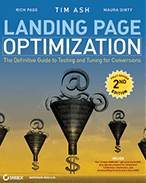Web Analytics Guru Interviews: Tim Ash
Last updated | Website optimization is one of the fastest growing, and in my opinion, one of the most impactful areas of online marketing. I have been a huge believer and fan of this field for quite some time now, so was very pleased to line up a major player in this field for my next web analytics guru interview: Tim Ash. Not only is he the author of an acclaimed new website optimization book (which I am currently reading) called ‘Landing Page Optimization‘, Tim is also the president of an exciting new website optimization company called SiteTuners. So without further ado, here is the interview with Tim:
Website optimization is one of the fastest growing, and in my opinion, one of the most impactful areas of online marketing. I have been a huge believer and fan of this field for quite some time now, so was very pleased to line up a major player in this field for my next web analytics guru interview: Tim Ash. Not only is he the author of an acclaimed new website optimization book (which I am currently reading) called ‘Landing Page Optimization‘, Tim is also the president of an exciting new website optimization company called SiteTuners. So without further ado, here is the interview with Tim:
Q: What are the most common mistakes you see when it comes to badly designed landing pages?
Tim: The most common one is excess clutter. Your page can’t be all things to all people. This applies to the layout, the graphics and colors, the amount of text, as well as the calls-to-action. By cutting away the clutter you let the visitor relax and focus on the desired conversion action. This results in a better user experience, and a higher conversion rate. Everyone is happy.
Q: Tell us what inspired you to write your recent Landing Page Optimization book?
Tim: The reason that I wrote the book (other than the fact that I am apparently a masochist who was willing to pull all-nighters to meet editorial deadlines) is that it was sorely needed. Sure there are a lot of excellent books about usability, web design, web analytics, and online copywriting. But no one had ever pulled everything together into one comprehensive guide that focused on landing page testing. There is a huge gulf between the mindset of the so-called “experts” and testing with your actual audience. On the one hand you have the autocratic king who will ride in on the horse and proclaim what you should do. On the other hand there is the messy democracy of your website visitors, who vote by their actions every time they visit your landing page. So you must get comfortable with the mindset that you don’t know everything, and will never be able to completely get into the hearts of your visitors. You must be humble and learn to present alternative page content and see what they actually prefer.
So testing is really about finding problems with your site and coming up with possible alternative solutions. It is also about the math and statistics of properly gathering and analyzing the data that you need to collect. And finally it is about the reality creating a testing culture within your company and getting everyone to cooperate. My book covers all of these topics. There are some additional resources at http://LandingPageOptimizationBook.com
Q: In your opinion, what is the most under-rated and under-used metric to help optimize websites?
Tim: I hear about “conversion” a lot. But when most people really use this term they mean simple “counting”. They do this because that is all that most landing page testing tools currently support. In the real world things are a lot more complicated. You may have several conversion goals with different values, and you can’t simply count them as interchangeable. In addition, you may have radically different profit margins on the things that you sell. So simply counting revenue will not do the trick either. If you reduce everything to a normalized profit-per-visitor number, then all of these issues go away. The hard part is actually optimizing for this metric.
Q: Other than Google Website Optimizer, what other tools do you recommend to help optimize websites and landing pages?
Tim: I want to first address the premise behind the question – tools are useless by themselves. Just because you have a hammer, does not mean that you know how to construct a house from scratch (Rich: I totally agree with you there Tim!). In much the same way, you need to understand what to test, and how to properly collect the data. If you do not test alternatives that improve conversion, then it does not matter what tools you use. Similarly, if you do not properly collect your data or analyze it without taking into account many common factors that can skew your results, your conclusions will be meaningless.
Having said that, and with my bias clearly displayed, I must say that our TuningEngine technology is head-and-shoulders better for high data rate environments. Most other tools are based on either A-B Split testing or variations of parametric multivariate testing (i.e. they build models of the expected conversion rate based on the settings of the variables in your test). These approaches include Design of Experiments and the Taguchi Method.
However, all of the arguments about which exact method to use come down to splitting hairs. All of the parametric approaches suffer from two fundamental limitations: the can’t scale up to large test sizes and they do not take variable interactions into account. So the discussions kind of sound like arguments about whether a b-b gun or a slingshot is the right way to stop a charging elephant.
Our TuningEngine technology was specifically developed to address these limitations. We routinely run tests with over 10,000,000 unique recipes, and we take context and variable interactions into account. The net result is that you can test many more good ideas and know that you are finding the best solution in the shortest time possible.
Q: What conferences have you found most useful for furthering your web analytics career?
Tim: Obviously eMetrics is a great conference specifically for web analytics. But I think that web analysts have to really become business process improvement specialists and look beyond their narrow niche. So I would recommend Search Engine Strategies, SMX, PPC Summit, AdTech, Affiliate Summit, and Webmaster World/PubCon as other events to attend.
Q: Tell us more about your company (SiteTuners.com), and what would you say is your best landing page optimization work?
Tim: Our parent company, Epic Sky, manages large-scale PPC campaigns. A few years ago we also started driving PPC traffic as a super affiliate. But we found that the landing pages that we were sending traffic to were very poor. So the larger opportunity turned out to be fixing landing pages. Since we launched SiteTuners four years ago, it has kind of turned into a tail-wagging-the-dog situation – SiteTuners now drives the bulk of our revenue and growth.
We are landing page optimization specialists and offer a full range of services. We have made hundreds of millions in extra profits for our clients, but I am often most proud for what we can do for mid-size and smaller businesses. Out hard-hitting Conversion Jumpstars are a perfect way to review a site or landing page and quickly identify and fix all of the obvious problems without testing. If you have a high enough data rate, you can graduate to full-service testing. We can do this on a fixed price or a pure-performance basis. Beyond that we want to educate our clients and make them self sufficient. That is why we make our state-of-the-art testing tools available in self-service mode. The bottom line is if you are not improving your conversion rates constantly your competitors will eventually eat your lunch.
So there you have it. Some great website optimization insight from Tim. And I will be sure to do a review of his book as soon as I have finished it. Does anyone have any questions for Tim? Simply add a comment below to ask him.



